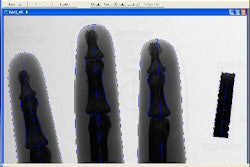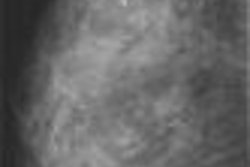VIENNA - A pair of presentations at Friday's European Congress of Radiology (ECR) demonstrated good results for ultrasound elastography, a new technique that measures the stiffness of breast tissue as a possible indicator of tumor malignancy.
Ultrasound elastography is being pursued as a method for possibly reducing the number of biopsies that are performed on suspicious lesions detected on screening mammography. While conventional ultrasound is already being used in this role, ultrasound elastography, or elastosonography, adds an additional parameter for characterizing tissue by measuring the differences in tissue stiffness. Benign tissue is typically softer and less stiff, while malignant tissue is stiff on an elastography scan.
Elastosonography uses a conventional ultrasound scanner that is outfitted with a flat plate on the transducer head, according to Dr. Martina Locatelli of Vittorio Emmanuelle Hospital in Gorizia, Italy. The exam is conducted by compressing the probe against the breast repeatedly for about five minutes, producing real-time color-coded images that demonstrate the differences in tissue strain that occur during compression.
Locatelli's group had conducted in-vitro and ex-vivo elastosonography scans, but for their ECR paper decided to conduct an in-vivo study to assess the technique's performance in a clinical setting. They examined 98 patients using an EUB 8500 Logos scanner (Hitachi Medical Systems, Tokyo). The group used a linear-array transducer at 7-13.5 MHz, and compared the elastography images with conventional b-mode ultrasound.
There were 145 lesions in the patient population, with five lesions excluded for technical reasons, leaving a total of 140 lesions that were evaluated. The group used a five-point scoring algorithm, with score 1 corresponding to very soft tissue, such as that characterized by a liquid-filled body. Score 4 was indicative of a totally stiff lesion, while score 5 indicated an area in which both the target lesion and surrounding tissue were extremely stiff.
The vast majority of benign lesions were in the score 1, 2, and 3 categories, Locatelli said, while most of the malignant lesions were graded score 5. There was a mix of benign and malignant lesions that were graded as score 4. The group also compared the size of lesions on elastosonography versus b-mode ultrasound.
The technique produced sensitivity in the range of 92% for characterizing malignant lesions, and specificity of 84% in characterizing fibroadenomas or tissue with either soft or mixed characteristics. Some 93% of cysts demonstrated normal tissue characteristics on elastosonography.
Locatelli said her group had developed a diagnostic algorithm based on a combination of the elastosonography results and tissue attenuation as measured by b-mode ultrasound. "If we have ultrasound attention and a score 4 or 5 on elastosonography, we do the biopsy," Locatelli said. "If we have score 2 or 3 on elastosonography with ultrasound attenuation, we wait and we decide to do the biopsy on the basis of all ultrasound signs."
The advantages of the technique are that it is relatively easy to perform and can be performed with a conventional ultrasound scanner, she said. It is also a good complement to conventional ultrasound, and can reduce unnecessary biopsies.
"Elastosonography complements conventional ultrasound and mammography in the evaluation of breast lesions, mostly BI-RADS III and IV," Locatelli said. "Elastosonography reduces the biopsy rate in atypical cysts, and may suggest appropriate workup for cancers with atypical presentation. Elastosonography might increase the accuracy of ultrasound in both diagnosis and staging of carcinomas."
In another presentation in the same session, another Italian group also evaluated elastosonography for breast applications. They examined 76 patients from November 2003 to August 2004, finding 89 lesions, of which 45 were malignant and 44 benign. Like Locatelli's group, they used a five-point scale to score the lesions, according to Dr. Luca Aiani of Valduce Hospital in Como.
The group achieved a sensitivity of 82.2% and a specificity of 97.7%, with an accuracy of 89.8%. The group reported particularly good results for lesions smaller than 2 cm -- an important result considering that conventional ultrasound tends to perform better in characterizing larger lesions, Aiani said.
"The diagnostic performance of elastosonography is demonstrated to increase with a reduction of lesion dimension," he said. "On the other hand, the diagnostic performance of conventional ultrasound is directly related to the dimension of the lesion. So these two different methods, ultrasound and elastosonography, have a complementary diagnostic role."
Both Locatelli and Aiani acknowledged that due to the novelty of the technique and the small patient size of their studies, additional research was needed before they could recommend the routine clinical use of elastosonography.
By Brian Casey
AuntMinnie.com staff writer
March 5, 2005
Related Reading
Prototype MR elastography reveals mechanical properties of breast cancer, July 25, 2002
Copyright © 2005 AuntMinnie.com



















